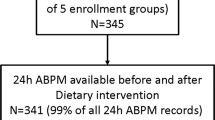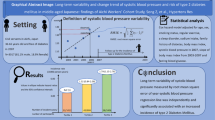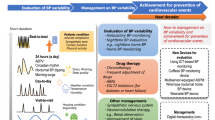Abstract
Altered blood pressure (BP) circadian rhythmicity has been increasingly linked with cardiovascular risk. However, little is known about BP circadian rhythm change with age and its possible sociodemographic, anthropometric, and genetic moderators. Twenty-four-hour ambulatory BP was measured up to 16 times over a 23-year period in 339 European Americans (EAs) and 293 African Americans (AAs), with an average age of 15 years at the initial visit. BP circadian rhythms were indexed by amplitude and percent rhythm (a measure of rhythm integrity) and calculated using Fourier analysis. BP amplitude and percent rhythm increased with age and average BP (BP mesor). AAs were more likely to have lower BP amplitude and percent rhythm than their EA counterparts. BP amplitude and percent rhythm also decreased with adiposity (BMI and waist circumference). The summer season was associated with lower BP amplitude in AAs and lower percent rhythm in both AAs and EAs. Sex, height, socioeconomic status, physical activity, and family history of essential hypertension did not have an independent impact on BP amplitude or percent rhythm. The results of the present study suggest that BP circadian rhythm increases with age and BP mesor from childhood to young adulthood, decreases with adiposity, and that AAs are more likely to have lower circadian rhythm than EAs. Furthermore, we demonstrated that the summer season is associated with lower BP rhythmicity.
This is a preview of subscription content, access via your institution
Access options
Subscribe to this journal
Receive 12 digital issues and online access to articles
$119.00 per year
only $9.92 per issue
Buy this article
- Purchase on Springer Link
- Instant access to full article PDF
Prices may be subject to local taxes which are calculated during checkout



Similar content being viewed by others
Data availability
The data analyzed during this study can be found within the published article and its supplementary files or, if further information is desired, from the corresponding author on reasonable request.
References
Reppert SM, Weaver DR. Coordination of circadian timing in mammals. Nature. 2002;418:935–41.
Rudic RD, McNamara P, Reilly D, Grosser T, Curtis AM, Price TS, et al. Bioinformatic analysis of circadian gene oscillation in mouse aorta. Circulation. 2005;112:2716–24.
McNamara P, Seo SB, Rudic RD, Sehgal A, Chakravarti D, FitzGerald GA. Regulation of CLOCK and MOP4 by nuclear hormone receptors in the vasculature: a humoral mechanism to reset a peripheral clock. Cell. 2001;105:877–89.
Millar-Craig MW, Bishop CN, Raftery EB. Circadian variation of blood-pressure. Lancet. 1978;1:795–7.
Li P, Sur SH, Mistlberger RE, Morris M. Circadian blood pressure and heart rate rhythms in mice. Am J Physiol. 1999;276:R500–4.
Degaute JP, van de Borne P, Linkowski P, Van Cauter E. Quantitative analysis of the 24-hour blood pressure and heart rate patterns in young men. Hypertension. 1991;18:199–210.
Chen L, Yang G. Recent advances in circadian rhythms in cardiovascular system. Front Pharm. 2015;6:71.
Perez-Lloret S, Aguirre AG, Cardinali DP, Toblli JE. Disruption of ultradian and circadian rhythms of blood pressure in nondipper hypertensive patients. Hypertension. 2004;44:311–5.
Litwin M, Simonetti GD, Niemirska A, Ruzicka M, Wuhl E, Schaefer F, et al. Altered cardiovascular rhythmicity in children with white coat and ambulatory hypertension. Pediatr Res. 2010;67:419–23.
Niemirska A, Litwin M, Feber J, Jurkiewicz E. Blood pressure rhythmicity and visceral fat in children with hypertension. Hypertension. 2013;62:782–8.
Hadtstein C, Wuhl E, Soergel M, Witte K, Schaefer F, H. German Study Group for Pediatric. Normative values for circadian and ultradian cardiovascular rhythms in childhood. Hypertension. 2004;43:547–54.
Wolfenstetter A, Simonetti GD, Poschl J, Schaefer F, Wuhl E. Altered cardiovascular rhythmicity in children born small for gestational age. Hypertension. 2012;60:865–70.
Wuhl E, Hadtstein C, Mehls O, Schaefer F, E.T. Group. Ultradian but not circadian blood pressure rhythms correlate with renal dysfunction in children with chronic renal failure. J Am Soc Nephrol. 2005;16:746–54.
Matteucci E, Giampietro O. Circadian rhythm of blood pressure in diabetes mellitus: evidence, mechanisms and implications. Curr Diabetes Rev. 2012;8:355–61.
Ge D, Dong Y, Wang X, Treiber FA, Snieder H. The Georgia Cardiovascular Twin Study: influence of genetic predisposition and chronic stress on risk for cardiovascular disease and type 2 diabetes. Twin Res Hum Genet. 2006;9:965–70.
Mensah GA, Treiber FA, Kapuku GK, Davis H, Barnes VA, Strong WB. Patterns of body fat deposition in youth and their relation to left ventricular markers of adverse cardiovascular prognosis. Am J Cardiol. 1999;84:583–8.
Patel RS, Masi S, Taddei S. Understanding the role of genetics in hypertension. Eur Heart J. 2017;38:2309–12.
Harshfield GA, Barbeau P, Richey PA, Alpert BS. Racial differences in the influence of body size on ambulatory blood pressure in youths. Blood Press Monit. 2000;5:59–63.
Gierke CLC. Germaine, Chronomics analysis toolkit (CATkit). Biol Rhythm Res. 2015;47:163–81.
Wang X, Poole JC, Treiber FA, Harshfield GA, Hanevold CD, Snieder H. Ethnic and gender differences in ambulatory blood pressure trajectories: results from a 15-year longitudinal study in youth and young adults. Circulation. 2006;114:2780–7.
Thomas KA, Burr RL. Circadian research in mothers and infants: how many days of actigraphy data are needed to fit cosinor parameters? J Nurs Meas. 2008;16:201–6.
Xu Y, Su S, Brown M, Snieder H, Harshfield G, Wang X. Ethnic differences and heritability of blood pressure circadian rhythm in African and European American youth and young adults. J Hypertens. 2022;40:163–70.
Perez-Lloret S, Toblli JE, Vigo DE, Cardinali DP, Milei J. Infradian awake and asleep systolic and diastolic blood pressure rhythms in humans. J Hypertens. 2006;24:1273–9.
Kent ST, Howard G, Crosson WL, Prineas RJ, McClure LA. The association of remotely-sensed outdoor temperature with blood pressure levels in REGARDS: a cross-sectional study of a large, national cohort of African-American and white participants. Environ Health. 2011;10:7.
Saner C, Simonetti GD, Wuhl E, Mullis PE, Janner M. Circadian and ultradian cardiovascular rhythmicity in obese children. Eur J Pediatr. 2016;175:1031–8.
Stepnowsky CJ Jr., Nelesen RA, DeJardin D, Dimsdale JE. Socioeconomic status is associated with nocturnal blood pressure dipping. Psychosom Med. 2004;66:651–5.
Campbell TS, Key BL, Ireland AD, Bacon SL, Ditto B. Early socioeconomic status is associated with adult nighttime blood pressure dipping. Psychosom Med. 2008;70:276–81.
Euteneuer F, Mills PJ, Pung MA, Rief W, Dimsdale JE. Neighborhood problems and nocturnal blood pressure dipping. Health Psychol. 2014;33:1366–72.
Funding
This study was supported by Grants HL069999 and HL143440 from the National Institute of Health.
Author information
Authors and Affiliations
Contributions
Katerina Massengale (BS): Performed the data analysis and drafted the manuscript. Yanyan Xu (PhD): Performed the data analysis. Harold Snieder (PhD): Data collection; made critical changes on the manuscript. Shaoyong Su (PhD): Data collection, performed the analysis, and made critical changes on the manuscript. Xiaoling Wang (MD/PhD): Designed the study and drafted the manuscript.
Corresponding author
Ethics declarations
Competing interests
The authors declare no competing interests.
Ethics approval and consent to participate
The Institutional Review Board at the Medical College of Georgia gave its approval for the study. Informed consent was provided by all participants or by parents if participants were less than 18 years of age.
Additional information
Publisher’s note Springer Nature remains neutral with regard to jurisdictional claims in published maps and institutional affiliations.
Rights and permissions
Springer Nature or its licensor (e.g. a society or other partner) holds exclusive rights to this article under a publishing agreement with the author(s) or other rightsholder(s); author self-archiving of the accepted manuscript version of this article is solely governed by the terms of such publishing agreement and applicable law.
About this article
Cite this article
Massengale, K., Xu, Y., Snieder, H. et al. A longitudinal study of blood pressure circadian rhythm from childhood to early adulthood. J Hum Hypertens (2024). https://doi.org/10.1038/s41371-024-00911-8
Received:
Revised:
Accepted:
Published:
DOI: https://doi.org/10.1038/s41371-024-00911-8



